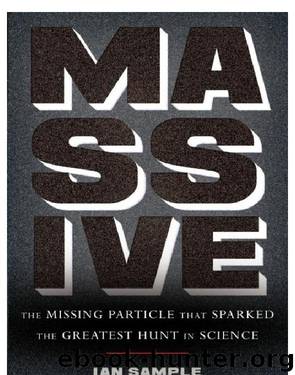Massive by Ian Sample

Author:Ian Sample
Language: eng
Format: mobi
Publisher: Basic Books
Published: 2010-09-28T20:00:00+00:00
David Miller likes to sing baritone and popularize science, and on occasion he does both at the same time. He also lays claim to being in one of the most unruly mathematics classes in 1960s London, one that happened to be taught by Peter Higgs at University College.
After his stint at the university, Miller spent time at Brookhaven National Laboratory in New York and at Fermilab near Chicago, but later on he returned to Europe and took a job at CERN. When Miller arrived at the laboratory, the LEP collider had been up and running for a while and had produced some beautiful results. What it had not produced—as far as anyone could tell—was any real evidence of a Higgs boson.
One afternoon, Miller left his office at the lab and climbed aboard a shuttle bus that had pulled up to take people to Geneva airport. As he sat waiting, the bus filled up with science journalists who were on a visit to find out what physicists at the laboratory were doing. Before long, he fell into conversation with them. “They said they had been to see this fellow, John Ellis, who had been trying to explain to them what the Higgs boson was,” Miller recalls. “They hadn’t understood a word of it.”
Exasperated, the journalists begged Miller to explain the Higgs boson in the simplest language he could find. Miller sat and thought for a moment. He wasn’t sure he could make them grasp it. Then he had an idea. “Imagine all you men are in a room and you’re arguing about some story or other, when all of a sudden a very beautiful woman walks in.” He paused to let them imagine. “As she walks through the room, those of you nearby forget what you were arguing about and form a cluster around her. By gathering around her, you impede her progress, you slow her down. It’s as if she’s become heavier.” The analogy had flaws, but the journalists got it. The room of reporters represented the Higgs field. The woman was a particle that gained mass by interacting with the field. And the cluster of fawning men was the Higgs boson.
While LEP was running, CERN had one eye on the machine’s successor, the Large Hadron Collider, which they hoped to build in the same underground tunnel. Before the project could be approved, CERN needed to be sure it had the backing of the countries that funded the lab. But the request for support came at a bad time for the British government. Margaret Thatcher had just left office and had been replaced by John Major, who was looking to make deep cuts in the physics budget. Britain’s continued involvement in CERN was in the balance.
In April 1993, Britain’s Institute of Physics held its annual conference in Brighton on the south coast. The talk everyone wanted to hear came from William Waldegrave, the science minister. Echoing the words of his former boss at the Royal Society in 1989, Margaret Thatcher,
Download
This site does not store any files on its server. We only index and link to content provided by other sites. Please contact the content providers to delete copyright contents if any and email us, we'll remove relevant links or contents immediately.
The Complete Stick Figure Physics Tutorials by Allen Sarah(7258)
Secrets of Antigravity Propulsion: Tesla, UFOs, and Classified Aerospace Technology by Ph.D. Paul A. Laviolette(5232)
Thing Explainer by Randall Munroe(3842)
The River of Consciousness by Oliver Sacks(3490)
The Order of Time by Carlo Rovelli(3091)
How To by Randall Munroe(2962)
A Brief History of Time by Stephen Hawking(2905)
I Live in the Future & Here's How It Works by Nick Bilton(2896)
The Great Unknown by Marcus du Sautoy(2609)
What If?: Serious Scientific Answers to Absurd Hypothetical Questions by Randall Munroe(2583)
Midnight in Chernobyl by Adam Higginbotham(2427)
Blockchain: Ultimate Step By Step Guide To Understanding Blockchain Technology, Bitcoin Creation, and the future of Money (Novice to Expert) by Keizer Söze(2404)
Networks: An Introduction by Newman Mark(2298)
The Meaning of it All by Richard Feynman(2264)
Easy Electronics by Charles Platt(2245)
The Tao of Physics by Fritjof Capra(2198)
Midnight in Chernobyl: The Untold Story of the World's Greatest Nuclear Disaster by Adam Higginbotham(2122)
When by Daniel H Pink(2053)
Introducing Relativity by Bruce Bassett(2043)
